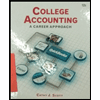
Horngren's Financial & Managerial Accounting, The Managerial Chapters Plus MyLab Accounting with Pearson eText - Access Card Package (6th Edition)
6th Edition
ISBN: 9780134674674
Author: MILLER-NOBLES
Publisher: PEARSON
expand_more
expand_more
format_list_bulleted
Question
Chapter 2, Problem 10RQ
To determine
Transaction: The economic events which bring about any changes in the financial items of a business and can be measured in the monetary units is referred to as a transaction.
To indicate: The place of initial recording of transactions
Expert Solution & Answer
Want to see the full answer?
Check out a sample textbook solution
Students have asked these similar questions
I am searching for the accurate solution to this financial accounting problem with the right approach.
Need Answer with relevant General Accounting Method
Need Answer with general Accounting Solving Method
Chapter 2 Solutions
Horngren's Financial & Managerial Accounting, The Managerial Chapters Plus MyLab Accounting with Pearson eText - Access Card Package (6th Edition)
Ch. 2 - The detailed record of the changes in a particular...Ch. 2 - Which of the following accounts is a liability? a....Ch. 2 - The left side of an account is used to record...Ch. 2 - Which of the following statements is correct? a....Ch. 2 - Prob. 5QCCh. 2 - Prob. 6QCCh. 2 - Posting a 2,500 purchase of office supplies on...Ch. 2 - Prob. 8QCCh. 2 - Which sequence correctly summarizes the accounting...Ch. 2 - Nathville Laundry reported assets of 800 and...
Ch. 2 - Identify the three categories of the accounting...Ch. 2 - What is the purpose of the chart of accounts?...Ch. 2 - What does a ledger show? Whats the difference...Ch. 2 - Prob. 4RQCh. 2 - Prob. 5RQCh. 2 - Prob. 6RQCh. 2 - When are credits increases? When are credits...Ch. 2 - Prob. 8RQCh. 2 - What are source documents? Provide examples of...Ch. 2 - Prob. 10RQCh. 2 - Explain the five steps in journalizing and posting...Ch. 2 - Prob. 12RQCh. 2 - Prob. 13RQCh. 2 - What is the purpose of the trial balance?Ch. 2 - Prob. 15RQCh. 2 - If total debits equal total credits on the trial...Ch. 2 - What is the calculation for the debt ratio?...Ch. 2 - Identifying accounts Consider the following...Ch. 2 - Identifying increases and decreases in accounts...Ch. 2 - Identifying normal balances For each account,...Ch. 2 - Prob. 2.4SECh. 2 - S2-5 Journalizing transactions
John Daniel opened...Ch. 2 - S2-6 Journalizing transactions
Harper Sales...Ch. 2 - Prob. 2.7SECh. 2 - Prob. 2.8SECh. 2 - Prob. 2.9SECh. 2 - Using accounting vocabulary March the accounting...Ch. 2 - Creating a chart of accounts Raymond Autobody Shop...Ch. 2 - Identifying accounts, increases in accounts, and...Ch. 2 - Identifying increases and decreases in accounts...Ch. 2 - Identifying source documents For each transaction,...Ch. 2 - Analyzing and journalizing transactions As the...Ch. 2 - Use the following information to answer Exercises...Ch. 2 - Prob. 2.17ECh. 2 - Use the following information to answer Exercises...Ch. 2 - Use the following information to answer Exercises...Ch. 2 - Analyzing transactions from T-accounts The first...Ch. 2 - Prob. 2.21ECh. 2 - E2-22 Preparing a trial balance
The accounts of...Ch. 2 - Prob. 2.23ECh. 2 - Prob. 2.24ECh. 2 - Prob. 2.25ECh. 2 - Prob. 2.26ECh. 2 - Prob. 2.27ECh. 2 - Prob. 2.28ECh. 2 - P2-29A Journalizing transactions, posting journal...Ch. 2 - P2-30A Journalizing transactions, posting journal...Ch. 2 - Prob. 2.31APCh. 2 - Prob. 2.32APCh. 2 - Prob. 2.33APCh. 2 - Prob. 2.34APCh. 2 - Prob. 2.35BPCh. 2 - Prob. 2.36BPCh. 2 - Prob. 2.37BPCh. 2 - Prob. 2.38BPCh. 2 - Prob. 2.39BPCh. 2 - Prob. 2.40BPCh. 2 - Prob. 2.42CPCh. 2 - Prob. 2.43PSCh. 2 - Prob. 2.1TICh. 2 - Your friend, Dean McChesney, requested that you...Ch. 2 - Prob. 2.1EICh. 2 - Roy Akins was the accounting manager at Zelco, a...Ch. 2 - Prob. 2.1FSCCh. 2 - In 35 words or fewer, explain the difference...
Knowledge Booster
Learn more about
Need a deep-dive on the concept behind this application? Look no further. Learn more about this topic, accounting and related others by exploring similar questions and additional content below.Similar questions
- Please provide the correct answer to this financial accounting problem using valid calculations.arrow_forward20 Nelson and Murdock, a law firm, sells $8,000,000 of four-year, 8% bonds priced to yield 6.6%. The bonds are dated January 1, 2026, but due to some regulatory hurdles are not issued until March 1, 2026. Interest is payable on January 1 and July 1 each year. The bonds sell for $8,388,175 plus accrued interest. In mid-June, Nelson and Murdock earns an unusually large fee of $11,000,000 for one of its cases. They use part of the proceeds to buy back the bonds in the open market on July 1, 2026 after the interest payment has been made. Nelson and Murdock pays a total of $8,456,234 to reacquire the bonds and retires them. Required1. The issuance of the bonds—assume that Nelson and Murdock has adopted a policy of crediting interest expense for the accrued interest on the date of sale.2. Payment of interest and related amortization on July 1, 2026.3. Reacquisition and retirement of the bonds.arrow_forward13 Which of the following is correct about the difference between basic earnings per share (EPS) and diluted earnings per share? Question 13 options: Basic EPS uses comprehensive income in its calculation, whereas diluted EPS does not. Basic EPS is not a required disclosure, whereas diluted EPS is required disclosure. Basic EPS uses total common shares outstanding, whereas diluted EPS uses the weighted-average number of common shares. Basic EPS is not adjusted for the potential dilutive effects of complex financial structures, whereas diluted EPS is adjusted.arrow_forward
- Which is not an objective of internal controls?A. Safeguard assetsB. Improve profitsC. Ensure accurate recordsD. Promote operational efficiencyarrow_forwardI need help finding the accurate solution to this general accounting problem with valid methods.arrow_forwardNelson and Murdock, a law firm, sells $8,000,000 of four-year, 8% bonds priced to yield 6.6%. The bonds are dated January 1, 2026, but due to some regulatory hurdles are not issued until March 1, 2026. Interest is payable on January 1 and July 1 each year. The bonds sell for $8,388,175 plus accrued interest. In mid-June, Nelson and Murdock earns an unusually large fee of $11,000,000 for one of its cases. They use part of the proceeds to buy back the bonds in the open market on July 1, 2026 after the interest payment has been made. Nelson and Murdock pays a total of $8,456,234 to reacquire the bonds and retires them. Required1. The issuance of the bonds—assume that Nelson and Murdock has adopted a policy of crediting interest expense for the accrued interest on the date of sale.2. Payment of interest and related amortization on July 1, 2026.3. Reacquisition and retirement of the bonds. Question 20 options: Paragrapharrow_forward
- Nelson and Murdock, a law firm, sells $8,000,000 of four-year, 8% bonds priced to yield 6.6%. The bonds are dated January 1, 2026, but due to some regulatory hurdles are not issued until March 1, 2026. Interest is payable on January 1 and July 1 each year. The bonds sell for $8,388,175 plus accrued interest. In mid-June, Nelson and Murdock earns an unusually large fee of $11,000,000 for one of its cases. They use part of the proceeds to buy back the bonds in the open market on July 1, 2026 after the interest payment has been made. Nelson and Murdock pays a total of $8,456,234 to reacquire the bonds and retires them. Required1. The issuance of the bonds—assume that Nelson and Murdock has adopted a policy of crediting interest expense for the accrued interest on the date of sale.2. Payment of interest and related amortization on July 1, 2026.3. Reacquisition and retirement of the bonds. Question 20 options: Paragrapharrow_forward11 Which statement is correct about accounting for financial instruments? Question 11 options: All financial instruments are accounted for at fair value through OCI. All financial instruments are accounted for at amortized cost. All are accounted for in accordance to their economic substance. All financial instruments are accounted for at fair value through profit or loss.arrow_forwardWhich of the following is correct about the difference between basic earnings per share (EPS) and diluted earnings per share? Question 13 options: Basic EPS uses comprehensive income in its calculation, whereas diluted EPS does not. Basic EPS is not a required disclosure, whereas diluted EPS is required disclosure. Basic EPS uses total common shares outstanding, whereas diluted EPS uses the weighted-average number of common shares. Basic EPS is not adjusted for the potential dilutive effects of complex financial structures, whereas diluted EPS is adjusted.arrow_forward
arrow_back_ios
SEE MORE QUESTIONS
arrow_forward_ios
Recommended textbooks for you
- Principles of Accounting Volume 1AccountingISBN:9781947172685Author:OpenStaxPublisher:OpenStax College
 Cornerstones of Cost Management (Cornerstones Ser...AccountingISBN:9781305970663Author:Don R. Hansen, Maryanne M. MowenPublisher:Cengage LearningCentury 21 Accounting Multicolumn JournalAccountingISBN:9781337679503Author:GilbertsonPublisher:Cengage
Cornerstones of Cost Management (Cornerstones Ser...AccountingISBN:9781305970663Author:Don R. Hansen, Maryanne M. MowenPublisher:Cengage LearningCentury 21 Accounting Multicolumn JournalAccountingISBN:9781337679503Author:GilbertsonPublisher:Cengage  College Accounting (Book Only): A Career ApproachAccountingISBN:9781337280570Author:Scott, Cathy J.Publisher:South-Western College Pub
College Accounting (Book Only): A Career ApproachAccountingISBN:9781337280570Author:Scott, Cathy J.Publisher:South-Western College Pub College Accounting (Book Only): A Career ApproachAccountingISBN:9781305084087Author:Cathy J. ScottPublisher:Cengage Learning
College Accounting (Book Only): A Career ApproachAccountingISBN:9781305084087Author:Cathy J. ScottPublisher:Cengage Learning

Principles of Accounting Volume 1
Accounting
ISBN:9781947172685
Author:OpenStax
Publisher:OpenStax College

Cornerstones of Cost Management (Cornerstones Ser...
Accounting
ISBN:9781305970663
Author:Don R. Hansen, Maryanne M. Mowen
Publisher:Cengage Learning

Century 21 Accounting Multicolumn Journal
Accounting
ISBN:9781337679503
Author:Gilbertson
Publisher:Cengage


College Accounting (Book Only): A Career Approach
Accounting
ISBN:9781337280570
Author:Scott, Cathy J.
Publisher:South-Western College Pub

College Accounting (Book Only): A Career Approach
Accounting
ISBN:9781305084087
Author:Cathy J. Scott
Publisher:Cengage Learning
ACCOUNTING BASICS: Debits and Credits Explained; Author: Accounting Stuff;https://www.youtube.com/watch?v=VhwZ9t2b3Zk;License: Standard Youtube License